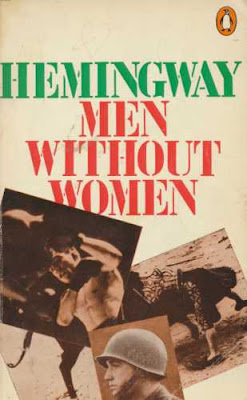I wrote about Hemingway and crime in my online Crime Beat column in 2009.
You can read the column below:
In Ellery Queen's Book of Mystery Stories, first published under the title The Literature of Crime, the crime stories presented in the collection are written by writers generally not recognized as crime, mystery or thriller writers.
Edited by Ellery Queen, the pseudonym of the writing team of Frederic Dannay and James Yaffe, as well as the name of their fictional detective character, the book offers crime stories by Mark Twain, Charles Dickens, Robert Louis Stevenson and a dozen other writers.
Included in the collection is a classic crime story by Ernest Hemingway called The Killers. The short story is one of my favorites and it is perhaps Hemingway’s best short story.“Ernest Hemingway’s The Killers is one of the best known short stories ever written and no volume dedicated to the literature of crime would be complete without it,” the editors wrote in the introduction to the story.
“It is revealing nothing new about Hemingway to point out that essentially he is preoccupied with doom - more specifically, with death. It has been explained this way: ‘The I in Hemingway stories is the man that things are done to’ - and the final thing that is done to him, as to all of us, is death. No story of Hemingway illustrates this fundamental thesis more clearly than The Killers; nor does any story of Hemingway’s illustrate more clearly why he is a legend in his own lifetime. Here, in a few pages, is the justly famous Hemingway dialogue - terse, clipped, the quintessence of realistic speech; here in a few pages, are more than the foreshadowings of the great literary qualities to be found in A Farewell to Arms and For Whom the Bell Tolls.”
He was wounded, returned home and he soon after began covering crime and other subjects for The Toronto Star Weekly. Hemingway credited his sparse, tough style of writing to his working for those newspapers with their quick deadlines. Hemingway By-Line offers a good collection of his newspaper and magazine pieces.
Humphrey Bogart portrayed Hemingway’s tough-guy hero, Harry Morgan, in the film version of the novel. Bogart, of course, also portrayed crime fiction’s iconic characters Philip Marlowe in Raymond Chandler’s The Big Sleep and Sam Spade in Dashiell Hammett’s The Maltese Falcon.
I heard Elmore Leonard, one of our best contemporary crime writers, tell his audience at the Philadelphia Free Library some months ago that Hemingway had been a main influence on him (although he lamented that Hemingway lacked a sense of humor). Many other crime writers, as well as writers of all stripes, list Hemingway as a major influence.
I do as
well.
I devoured crime fiction and thrillers as a
teenager. I read Ian Fleming, Raymond Chandler, Dashiell Hammett and Ed McBain,
to name but a few. I also read literary fiction and Hemingway’s novels were a
favorite of mine.
After serving two years on an aircraft carrier
during the Vietnam War, I was stationed on a Navy tugboat at the U.S. nuclear
submarine base in Holy Loch, Scotland for two years. I was in my early 20s then
and I discovered Hemingway’s short stories, which I liked even better than his
novels.
I was pleased that some of them, like The Killers and The
Battler were first-rate crime stories.
I traveled throughout the United Kingdom and
Europe during those years. I visited Italy, France and Spain, which were
the settings for many of Hemingway’s stories. While traveling across Europe I
always carried what we called in the Navy an “AWOL” bag. In the small carry-all
bag, among my toilet articles and a change or two of clothes, were several
Penguin paperbacks books.
I loved those classic orange and white paperbacks and I still have many of them today. I bought and read Penguin’s Evelyn Waugh and Anthony Burgess novels, Mark Twain’s travel books, and many other classic books. I carried several of these paperbacks in my AWOL bag, along with Hemingway’s Penguin paperback short story collections, such as Men Without Women and The Short Happy Life of Francis Macomber. I read and reread these great stories.
Except for his tragic end, Hemingway led what many writers consider the ideal writer’s life. He was successful, wealthy and popular. He had the freedom to travel the world and hunt and fish, drink and talk in bars, and cover what interested him.
Hemingway covered wars, crime, sporting events
and other happenings - and then returned home to write about his adventures.
Hemingway truly loved the sea and he lived near
the ocean in Key West, Florida and later in Cuba. I visited his home in Key
West some years back and I hope to one day visit his home in Cuba once the
communists are finally kicked off the island.
Hemingway died by his own hand in 1961, but he
lives on with his novels and stories. His family is releasing a newly-edited
version of A Moveable Feast and there are two major film
productions in the works about his work and his life.
Hemingway is influencing yet a new generation of
writers and readers.
“Courage is grace under pressure,” Hemingway
once wrote.
He also wrote “A man can be destroyed but not
defeated."







No comments:
Post a Comment